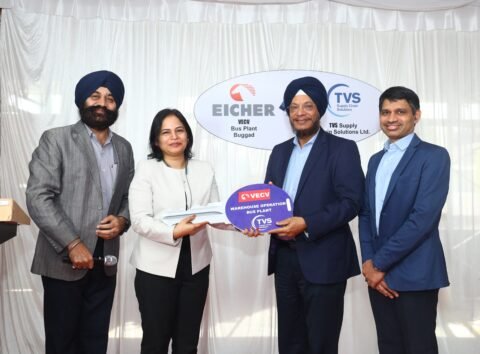Hamburger Hafen und Logistik AG (HHLA) and Munich-based truck manufacturer MAN Truck & Bus successfully carried out practice tests with a self-driving truck for the first time.
The test was carried out in regular container traffic at HHLA Container Terminal Altenwerder (CTA) as part of the two companies’ project to develop and test self-driving trucks for use in hub-to-hub container traffic.
The research project, dubbed the Hamburg TruckPilot project, aims to develop automation solutions for road transport. It is part of the strategic mobility partnership between the Free and Hanseatic City of Hamburg and the Volkswagen Group.
Specifically, it focusses on customer-specific deployment and the feasibility of integrating self-driving trucks in the container handling process at the CTA, which serves as a highly automated testing ground.
The German parliament and the Federal Council recently passed a law that makes deployment of autonomous driving systems possible in principle in Germany when they take place in defined routes between logistics hubs, and when they are monitored by technical solutions.
HHLA and MAN Truck & Bus have been driving forward the Hamburg TruckPilot research and testing project since the end of 2018 to develop automation solutions. Following the preparation and test phase, the highlight was the practical test drives at the end of May, during which prototype trucks equipped with electronic automation systems ran in regular logistics operations.
As part of the two-day practice tests, Spedition Weets brought 40ft containers from Weets Logistic Centre in Soltau to Hamburg on behalf of VW Group Logistics.
A wide range of data for automated driver was already collected along the A7 motorway on the route to Hamburg.
Detlev Gosler, a driver with Emden-based freight forwarder Spedition Weets said, “This is how the future feels.”
Though Gosler regularly drives his truck to HHLA CTA, during the tests the prototype of this self-driving truck steered itself across the terminal almost autonomously.
The Spedition Weets driver moved to the passenger seat at the check-in gate at the entrance to CTA to make way for a trained MAN safety driver, who monitored the autonomous driving functions and would take over the wheel if needed.
The prototype truck carefully accelerated on its own, approached the storage block at 25 km/h and manoeuvred the container chasses backwards into the assigned lane.
Following the handling of the container, the automated return trip to the check gate took place and the safety driver did not need to intervene a single time.
Till Schlumberger, Project Manager at HHLA said, “Autonomous driving is coming. The law on autonomous driving that was recently passed confirms it. At HHLA, we want to – and must – prepare ourselves at an early stage for the prospect of autonomous trucks picking up or delivering containers at our terminals.”
Sebastian Völl, Project Manager for Automated Driving at MAN Truck & Bus said, “Hamburg TruckPilot is an important technological milestone on the road to hub-to-hub automation.”
Jakob Weets, Managing Director of Spedition Weets said, “We are delighted to be part of this innovative research project and to support the development of future automated solutions.”
In the future, automated driving functionalities are expected to provide truck drivers with both support and relief.
Further potential advantages are found in the increase in efficiency that results from anticipatory, automated driving as well as significantly reducing fuel consumption and having the potential to positively influence the general flow of traffic.







